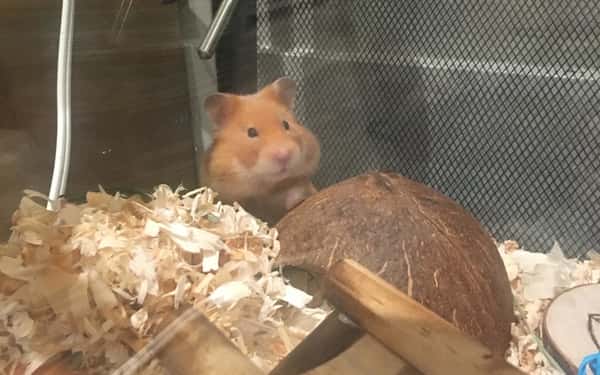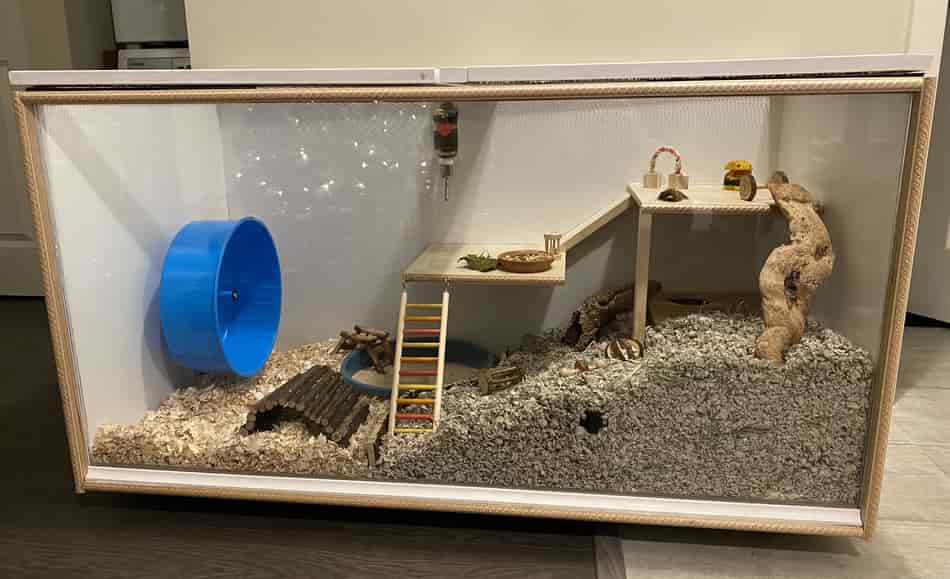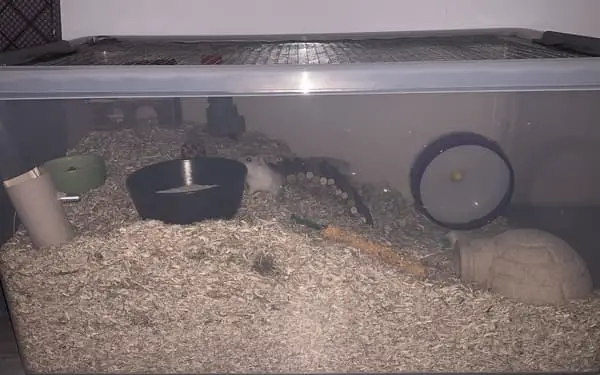Hamsters are great pets—they are small and adorable, easy to care for, and love human company. Sometimes, however, as with many pets, we humans are left with the conundrum of where to properly house our friends. Most rooms in a home are acceptable for hamster habitation, including the closet, with proper preparation.
So, can I put my hamster cage in my closet? If you have nowhere else to put an enclosure for your pet, a closet with doors open or off could work if the proper considerations are made.
In this article we will discuss how to go about choosing a space for your hamster and why a closet could work, within certain parameters. Additionally, we will discuss the hamster’s nocturnal nature and briefly cover burrowing, hamsters’ sharp yet delicate senses, and their environment.

Choosing the Best Space
One of the first things most people do before they bring home a new companion is figure out the best living space for it. Hamsters make great pets for a litany of reasons, not least of which is they do not take up a great deal of space. It is important to make sure a hamster’s enclosure is at least 24 inches by 12 inches and 12 inches high, although bigger is better.
Even the largest hamster enclosures typically do not take up much room, relatively speaking, in an average home or apartment. But the enclosure itself is not the only thing to consider—the environment surrounding a hamster’s habitat is just as important, if not more so, to consider when you bring home your new pet.
The basic things to consider when deciding where your new furry friend’s digs will be located is light, noise, and temperature. Hamsters are nocturnal, which we will discuss more in-depth shortly, so lighting should be gentle or low and consistent.
Additionally, a hamster’s senses can easily become overwhelmed, so ensuring the area is quiet is particularly important, which will be discussed later on as well. Finally, hamsters in the wild typically live around arid regions like deserts and steppes, so somewhere dry and warm is ideal for them to thrive.
Closets in many regions do not heat or cool consistently with other rooms in a home, so before choosing a closet as your friend’s new locale, make sure the “climate” is consistently conducive to a happy hamster.
Further, the door/doors should remain open or be removed entirely to provide adequate ventilation—never place your companion’s enclosure in a closet with the door closed.
You will also want to make sure your new friend’s habitat is secure, as hamsters can be escape artists! If you choose to place your pet’s enclosure in the closet, make sure both the enclosure itself and the closet are secure.
If the enclosure is going on the floor, make sure something is under the cage to prevent the hamster from chewing on carpeting, which could cause illness.
If you are placing it on another surface within the closet, ensure the surface is sized correctly to the enclosure and is stable. Finally, double-check your closet for open vents or holes in corners lest your pocket-sized pal end up in your walls!
Choosing a closet for your hamster’s cage can work provided you can take the measures listed above, mainly because unlike many other domestic pets, hamsters are nocturnal.
Night Owls
Hamsters in the wild are prey animals, meaning they are on the menu for several different predators in their given environments. Because of this, they not only live within underground burrows, but they are also nocturnal, meaning they are most active at night.
Additionally, they have sharp senses of hearing and smell, but their eyesight is not a strong point having evolved largely underground and in darkness. Nighttime is when wild hamsters emerge from their underground quarters to forage for food without having to worry about most predators.
Knowing this, keeping a hamster in a dark place like a closet seemingly makes a lot of sense, and it does—to a point. Being nocturnal, both wild and domestic hamsters spend most of their time conducting their various activities under cover of darkness.
However, they do need light sometimes, like most other animals, to keep their internal functions and sleep schedules correctly aligned. For this reason, taking extra measures like those listed above, specifically leaving doors open or removed, is important to maintain consistency for your furry friend.
Hamsters thrive on routine, so having closed doors during a time their little bodies think should be day can throw their schedules off and create stress, some symptoms of which will be examined below in the context of how our furry friends process and sense their environment.
Senses and Environment
As discussed above, hamsters in the wild have keen senses to detect predators in their environments and keep them safe. They also use these senses to navigate their intricate underground burrows that consist of tunnels and various rooms.
Because hamsters have only been domesticated for a noticeably short period of time, about a century or less, they are more like their wild cousins than most of our other housebound companions, which means these senses are still extremely sharp. Unfortunately for our furry friends, these senses are also quite delicate, and can be easily overwhelmed.
When considering a closet as the location for your hamster’s enclosure, keep your friend’s delicate senses in mind. If you are in and out of your closet multiple times a day, turning the light on and off, you may want to consider another area as hamsters are sensitive to bright light, and as mentioned earlier, need consistency.
Conversely, you can simply use the light in the main room to illuminate the closet for a lesser impact on your pal. Furthermore, hamsters are extremely sensitive to ultrasound which emanates from things like televisions, computers, and even pipes like those attached to household appliances.
Our ears cannot detect ultrasound, but it can be quite distressing for your hamster, so make sure the closet in question is well out of range of any items like these.
Another thing to consider regarding your hamster’s senses and environment are other occupants in the room. If the closet is connected to a room that is shared with rambunctious children or other pets, it might be time to consider using a different space for your companion’s digs.
Hamsters are typically well-behaved and happy with children, which is part of what makes them such popular pets, but the loud and often unpredictable noises of children playing in the immediate vicinity of the hamster’s home may induce stress.
Furthermore, other pets, especially naturally predatory ones like cats and dogs, likely will be a source of stress for your tiny pal if the animals spend long periods of time in the room together. Anytime you put your pal in a new location, or if you think some of these sensory stressors may apply to your current situation, keep an eye out for signs of stress like those listed below:
- Uncharacteristic or compulsive behavior (bar biting, sudden wheel addiction, excessive grooming)
- Uncharacteristic aggressiveness
- Hair loss
- Excessive salivation
- Grunting or snorting
- Persistent escape attempts
- Muscle rigidity or tremors
This list is not all-inclusive and varies from hamster to hamster allowing for personality, but it is important to be aware of these signs so you can help your furry friend.
If you recently moved your hamster into a closet and have been seeing these signs, consider finding a new place for it to inhabit, especially if the closet in question does not seem to fit with most of the parameters discussed above.
If you believe your closet is safe, lit and ventilated properly, and within an environment that is conducive to a happy, healthy pet, there is one more thing to keep in mind before your pocket-sized pal moves in.
Out of Sight, Not Out of Mind
Closet sizes and configurations vary quite broadly from home to home—some are large, walk-in rooms while others are glorified cupboards. Some are built at odd angles to accommodate different types of architecture and some are simple cubes of space. In any case, closets are often simple addendums to larger rooms and therefore can be overlooked quite easily.
If you choose to put your furry friend in the closet, make sure you are spending just as much time tending to it and the enclosure as you would if it were in any other part of your home. Hamster enclosures must stay clean and dry for your pet to thrive, and even though they are natural hoarders they need consistent access to fresh food and water.
Further, most hamsters simply enjoy being in the presence of their human companions and being relegated to a small closet might isolate them more than they would like. Therefore, if you choose a closet as your pal’s locale, invest plenty of time and energy into spending time there yourself.
Conclusion
If you are short on space or simply prefer your hamster’s enclosure go in a closet, you can make it work with proper light, ventilation, and environmental considerations. Because your pocket-sized pal is nocturnal, the natural darkness of a closet is ideal; however, they do still need light, so leave the doors open or off.
Additionally, keep your pet’s delicate senses in mind and make sure they are not exposed to ultrasound, loud noises, inconsistent lighting, or other pets. Finally, if your furry friend is going to live in a closet, expect to spend a good amount of time there as well, as they love your company.
With proper preparation, you can expect to have a happy, healthy hamster in your closet.




